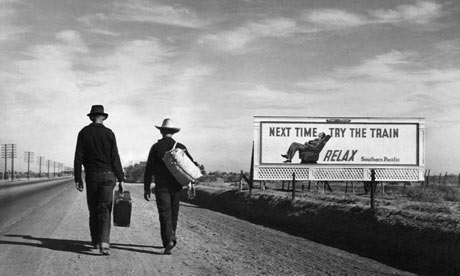
The second half of Joshua Ferris's frequently brilliant, often perplexing The Unnamed is a "road" novel of the most curious kind. There is, for example, no ultimate goal. Tim Farnworth, the central character, is neither running to, nor escaping from, anything. He is not particularly interested in the landscape around him, nor is he trying to find the mythical, romanticised heart of America. It is not a voyage of self-discovery; he does not fall foul of rednecks, hit-men or femmes fatales. Instead, Farnworth walks. He puts one foot in front of the other and stops only when he can no longer physically continue.
Farnworth, a high-flying, well-off lawyer, suffers from a unique condition which compels his body to walk whether he wants it to or not. It's a bold and intriguing conceit, and one that give Ferris an opportunity to explore both his character's and his country's true natures. In the early sections, Ferris takes him round alien parts of New York – an African hair-weave salon in the Lower Bronx, a granite slab in a cemetery, an abandoned Utz Potato Chip truck – before unveiling an America in the throes of real upheavals in the natural world.
The Unnamed is not an easy book to love, but it is provocative, unusual and emotionally acute. Its difficulty lies in Ferris's refusal – rightly, I think – to make this a conventional narrative. Not only is Farnworth's disease unnamed, it is also incurable, which means he is soon itinerant, walking endlessly with no real direction. While some have criticised the novel itself for meandering, I think this is its great virtue. Because there is no defined goal, we see only the depths of Tim's despair and the changing landscape around him. The walking brings both into sharp focus in a way any other method of transportation could not.
Literature has always had a close, personal relationship with walking, from which so much inspiration can be taken, and so much can be learned. It's no accident that it forms such an important part of so many novels: Leopold Bloom's promenades around Dublin; Mrs Dalloway's journeys across London; WG Sebald's negotiations of the East Anglian coast. Walking allows an opportunity to reflect, and to observe both those around us and the landscape that confines us.
Since Baudelaire's flâneur stalked the Paris streets, the artistic relationship with walking has changed. In 1955, Guy Debord's psychogeography suggested a ludic discipline that put walking and discovery at the heart of a new way of looking at cities and other landscapes. A decade or so later, the land artist movement – popularised by Robert Smithson and continued in the work of Richard Long, Andy Goldsworthy and Hamish Fulton – suggested another close artistic affinity with walking. As the world becomes ever faster-paced, the one reliable way to slow it down is to take a stroll.
At the beginning of The Crimson Petal and the White, Michel Faber warns the reader to "watch your step" as he leads them through the streets of the city. And this unpredictability is, I think, the great joy of literary walking: you never know who you're going to meet. That potential, and that ability to notice things that others might miss in their cars or on their bikes, gives such narratives an edge: one that The Unnamed displays superbly.

